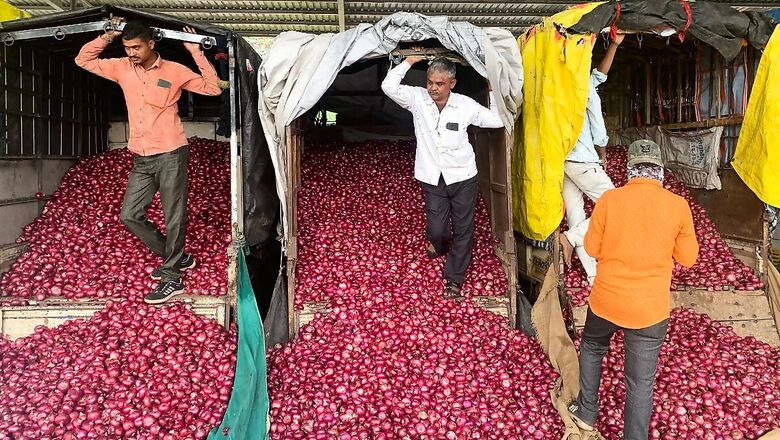
views
A farmer from Maharashtra, Krishna Dongre, 52, is one among many who has set his entire onion produce on fire. Reason? He could not recover the cost at which he had invested in the crop due to the sudden fall in the prices of onions in the wholesale market.
When News18 reached Krishna’s 1.5 acres of farming land in Niphad district in Nasik, he and his family were plucking the onions to not send it to the Lasalgaon Onion Market but to burn that entire produce. It was a tough decision for Krishna Dongre and his family to burn their entire produce but they were left with no option as market rates were so low.
“I agree that there is a situation of high yield in the state, but when oil-producing countries face a similar situation do they burn that extra oil? No, their governments manage the exports properly. We lack that and that’s in why countries like India, farmers always face such tough situations,” said Dongre.
Usually, a farmer spends Rs 1,100 to Rs 1,200 for production costs per quintal on onions but gets Rs 600-700 per quintal on selling his produce in the wholesale market.
While speaking with News18, Dongre blames the Centre and Maharashtra government’s policy and mismanagement behind the onion crisis. If the government would have taken the advice from an agriculture expert, then this issue would have been easily resolved, he said.
Many farmers, like Krishna Dongre, take farm loans from banks every year. But they are not able to repay it because they don’t get a good rate for their produce. To grow 100 quintal of onions on 1 acre, Dongre had spent around Rs 70,000. While selling the produce, he had to bear additional costs of Rs 25,000-Rs 30,000, which include transportation, packaging and labour charges. Then, in the market, he could sell the onions at the rate of Rs 600-700 per quintal.
Disappointed, Dongre decided to burn his entire onion produce. He said no politician or minister is concerned about the onion price issue and is ready to have a dialogue with farmers like him. “I had written a letter to the chief minister, deputy chief minister and other politicians to look into the issue, but no one responded. It seems that they don’t even care about farmers and their issues,” Dongre told News18 while setting up his produce on fire.
On his land, a young Amol Mundhe, who is an MBA in Marketing, has been farming for the last 15 years due to his passion and love for the job. He said a farmer should get a chance to decide the rate of his own produce, and blames the export policy of the Centre due to which traders are also not able to sell the onions to other countries.
According to the data, India exports onions to Bangladesh, Sri Lanka and Saudi Arabia, who have levied an import duty of Rs 3/ kg due to which exports have been halted. Indian onions are in a very high demand in Pakistan, but traders cannot sell them directly to the neighbouring country. Onions have to go through the Saudi market, hence, that door is also closed for India.
Apart from Maharashtra, Madhya Pradesh and Rajasthan are also facing the same challenge. “High yields in Maharashtra and other states is one of the reasons why the prices of onions are going down. But if our government exports these onions to countries like Kazakhstan, Belarus and Pakistan where the demand for Indian onions is higher, automatically, the rates will stabilised and farmers will get a good rate for their produce,” said Mundhe.
To find out what exactly is the situation on the ground, News18 reached Lasalgaon Onion Market, which is considered the biggest in Asia. From Monday to Saturday, live auctions of onions take place in this market, where farmers try to sell their produce at a better price and traders purchase them on the basis of quality and offer the price.
During the live auction, News18 met trader Pravin Kadam, who has been trading at Lasalgaon Onion market for the past 15 years. According to Kadam, the demand for onions has gone down due to increased production and hence it is affecting the prices. But transportation cost also plays a major role in determining the prices of onions. If the rack railway is not available to send off onion produce to other states, the prices start falling from the next day.
“There is no doubt that the bumper production of onions is one of the reasons for low prices, but transportation is also an issue. Most of the time, we don’t get rack railway to transport the purchased onions to other states or cities. We had requested the railways and central government many a times, but the situation remains the same. Which further affects the prices of onions. If we don’t get the rack railway to transport onions even for one day, the prices fall by Rs 30-Rs 50 per quintal,” said Kadam.
As an emergency measure, the state government has instructed the National Agricultural Cooperative Marketing Federation of India (NAFED) to start purchasing the onions from the market to stabilise the situation. From March 2, NAFED started buying onions from the farmers directly, but they have to produce some legal papers and bank account details. Also, NAFED has set some parameters for buying the onions that it should be bigger than 45mm, which means only high quality produce.
Farmers also fear that NAFED payment comes after 12 days of purchase, so they again feel the cash crunch. According to traders, NAFED is not doing direct purchases. It has appointed private farm-producing companies at each centre which only buy 300-400 quintals of onion per day. Hence, a marginal farmer, who is producing low grade onions, cannot sell his produce at such centres. Hence, efforts made by the government are not fully fledged.
According to the law of demand and supply, the high yield of onions has resulted getting low rate for crops not only in Indian but also in Asian markets. In such a scenario, farmers want the government to protect them by providing a minimum support price or subsidy. Else, in the coming days, many farmers may force to take the same action as Krishna Dongre did.
Read all the Latest India News here


















Comments
0 comment